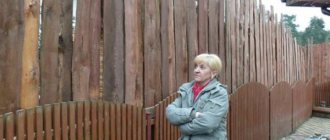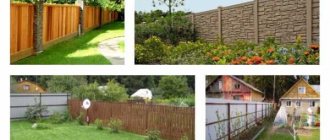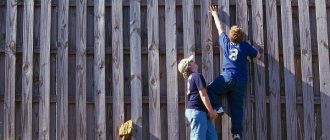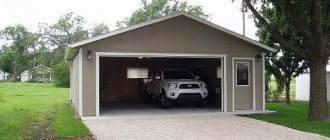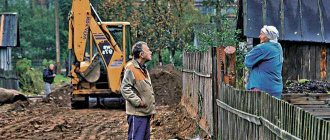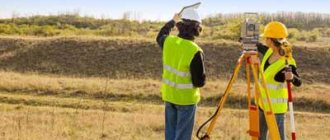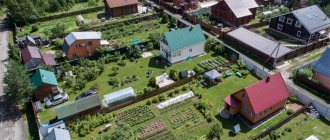The main purpose of installing a fence is to mark the boundaries of the estate, the additional purpose is protection, increasing the safety of property and residents.
Article on the topic: “Construction of a fence from corrugated sheets”
But when planning construction, it is necessary to take into account not only the wishes of the owners regarding the size and material of the fence, but also the requirements of the current legislation.
If there is an urgent need to install a high wall from neighbors, then you need to take into account the standards and the opinion of the other side.
Otherwise, a solid fence between neighbors can cause constant quarrels and even litigation.
Is it possible to install a blind fence between neighbors?
Since the beginning of 2021, significant amendments have been made to the legislation regarding the construction of fencing structures. In particular, the transparency of the fence is regulated by local governments. For different regions, the indicators vary significantly, since the calculations take into account relief and climatic conditions.
For clarification, please contact local services.
It affects the parameters of the fence from neighbors and the type of land on which the development will take place.
In TSN (SNT, ONT, DNP, LPH)
The Land Code of the Russian Federation states that according to their intended purpose, lands are divided into separate categories.
In accordance with Federal Law No. 217-FZ dated July 29, 2017, according to the type of application, plots are divided into agricultural lands and residential areas.
We recommend reading: “How to make a wooden fence from a picket fence”
The first category includes:
- DNP (dacha non-profit partnership);
- ONT (gardening non-profit partnership);
- SNT (gardening, horticultural non-profit partnership);
- Private household plots (personal subsidiary plots), only field plots.
But according to the updated version of the same law dated January 1, 2019, all DPN, ONT, SNT are transformed into TSN - a partnership of real estate owners.
The norms of the updated edition of SNiP for TSN are purely advisory in nature. The basic requirements for fencing are prescribed in the charters of each of the partnerships.
To erect a blind fence in SNT, you need to obtain written permission from the neighbors in the form of a deed and have it certified by a notary.
The main requirements for fences in SNT are to install them along the entire perimeter; the posts and logs must remain on the side of the construction initiator.
In private household plots, individual housing construction
This is the category of land in settlements:
- IZHS (individual residential construction);
- Private household plots (personal subsidiary plots), only household plots.
The requirements of SNiP dated 02/30/97 do not apply to the lands of private household plots and individual housing construction. When erecting a fence, you should proceed from the land use and development rules (land use and development rules) of the local municipality.
If the local PZZ does not have clear restrictions regarding the parameters of the fence, this does not mean that the installation can be carried out entirely at the discretion of one party or completely abandon the fence.
It is recommended to install a small chain-link fence up to 1.5 m high around the garden. When using corrugated sheeting or other shading material in an adjacent area, you will have to ask for the consent of the other party.
In the country
It is important to take into account that development on a summer cottage site can be carried out for 10 years. During this time, the owners need to at least have time to build a residential building and a fence. If after 10 years the site is not completely developed, then the permit can be extended, but the reasons for such delay will have to be explained.
Requirements for dacha fences between neighbors are regulated by dacha cooperatives. They determine the list of recommended materials, height, and permissible degree of transparency.
The permissible height of the fence should not exceed 1.7 meters. Greater heights will have to be agreed upon with neighbors.
It is permissible to fence yourself off only with a transparent fence (made of metal, plastic mesh, polycarbonate). It is allowed to erect a solid fence on the street side, away from the road, field, or ravine.
In the private sector, village
If the site belongs to individual housing construction, then the fence must be installed only from the street.
There is no need to put a fence on the boundary. After all, in villages the plots of land are large, so installing a fence around the entire perimeter is costly. Often, budget fences are built from mesh just to outline the boundaries of the estate.
If a private house is located within the city, then the recommended height of the street fence is up to 2.2 m. If there is a gas pipe next to the estate, then to legally build a fence you will have to take a document from the gas service, which will authorize such structures without violating safety standards. In this case, the minimum distance of the fence from the pipe should be 5 m.
What to follow during construction?
The main legislative act regulating the process of planning and construction of structures on a land plot is the Code of the Russian Federation on Urban Planning. However, this document does not contain instructions on the mandatory placement of a blind fence between adjacent areas. Therefore, SNiPs are taken as a basis, that is, building codes and regulations, which can be supplemented by regulations adopted at the local government level. These documents specify the requirements for the construction of fences on the territory of a populated area, dictated by:
- climatic features of the region;
- dominant terrain;
- the presence of cultural heritage sites, etc.
It may also be necessary to obtain permission from local authorities to build a fence. The issuance of such permits is carried out in district and city administrations by the departments for urban planning and architecture, which ensure that the life support systems of the settlement (water supply, electrical networks, other utilities) are not located in the private fenced area. If an illegally constructed fence is discovered, the owner will be forced to dismantle it at his own expense.
Legal requirements and regulations
The fence at the boundary with the neighbor's property should be located strictly on the border of the two estates. You can determine whether this is true or not using a development plan (house book), where the dimensions of the territory and each building on it are clearly stated.
The development plan is prepared together with the cadastral number when entered into the unified register. It is the development plan that becomes the key evidence that one of the parties is right in court.
If the parties have no questions regarding the boundaries of the plots, then construction can begin, observing a number of legislative standards.
Documentation that must be read and followed includes:
- SNiP 30-02-97. You can find the full version of the official document here: .
- SP 53.13330.2011. For areas that belong to TSN. Full electronic version: .
- Federal Law of 2008 No. 123-FZ. .
- Civil Code of the Russian Federation, namely Article 51, paragraph 1, paragraph 17. .
It is important to take into account the requirements of local authorities. Obtain permission for construction from the architectural service.
Let us examine in more detail the legislative norms regarding the construction of fences that will separate two sections.
SNiP
The construction standards for TSN sections are regulated by the Code of Rules - SP 53.13330.2011 (updated version of SNiP 30-02-97) approved by order of the Ministry of Regional Development of the Russian Federation dated December 30, 2010 No. 849. By government order dated June 21, 2010 No. 1047-compliance with the Code of Rules is mandatory for all owners of TSN horticultural lands.
For detailed documentation, links are provided in the previous section.
Key excerpts from the fencing bills:
- The fence between two estates should be mesh or lattice (picket fence), so as not to create a shadow on the neighboring plot.
- By decision of the TSN members, it is permissible to install solid fences on the street side, away from the road.
- The permissible height of the fence on the border of two estates is 1.5 m.
- Key requirements for fencing are always specified in the charter of the partnership.
Even with full compliance with these requirements, it is recommended to agree on the parameters and fence material with your neighbors and document them.
SanPiN (sanitary standards)
Sanitary standards do not regulate the parameters of the fence, but its permissible distance from buildings.
Here are the basic recommendations regarding distances from the fence to other structures:
- to the toilet - 1 m;
- to a residential building - 3 m;
- to greenhouses, greenhouses - 1 m;
- to bushes - 1 m;
- to medium-sized trees - 2 m;
- to tall trees - 4 m;
- to outbuildings on the neighboring site - 1 m;
- to poultry houses, barnyards, cesspools - 12 m.
In this case, the slopes of the roofs of buildings that are located next to the fence should be inclined towards their own territory.
Thematic material:
- At what distance from the fence should a bathhouse be installed?
- Distance from the red line to the garage
Fire regulations
Fire safety rules are always mandatory and cannot be challenged, because they were created to protect residents, the property of a particular area and the entire settlement from fire.
These standards stipulate the permissible distances from the fence to buildings on your own and neighbors’ property.
Key fire safety requirements for fence installation distance:
- to flammable materials - 15 m;
- to buildings made of combustible materials - 8 m;
- to buildings made of non-combustible materials - 6 m.
Failure to comply with fire safety standards may result in the demolition of the fence.
You can learn more about the classification of buildings by flammability risk and other fire safety rules from the article: “Distance from a residential building to a fence.”
The procedure for approving construction with a neighbor
Agreeing verbally with your neighbors is not enough. The right thing to do is sign a written agreement certified by a notary. Only this document will have legal force in court.
You can ask a notary for a sample agreement. But if this does not turn out to be the case, then it’s okay, because there are no legal requirements for the form.
The main thing is that it contains the following data:
- Passport details of both parties.
- Cadastral numbers of estates.
- Description of the subject of the agreement: construction of a fence on the boundary, dimensions and materials used, type of foundation.
- Who pays the construction costs carries out the work.
- Date and place of creation of the agreement.
- Details of both parties and signatures.
The document is drawn up in two copies, one copy for each party. The agreement is kept for exactly as long as the fence lasts.
For TSN land owners, the approval procedure is slightly different:
- You need to carefully study the organization's charter. This is where the key requirements for installing a fence are indicated.
- Talk to your neighbors about building a fence. If there are no reasons for disputes, then draw up a written agreement.
- At a meeting of TSN members, coordinate your plans with the board, obtain approval for development in writing.
After this, you can begin construction work.
A deviation of even 10 cm from the boundary of the plots can cause quarrels. To avoid conflicts, it would be good to carry out a land surveying procedure.
How to find an experienced surveyor?
You can find a competent surveyor through your friends who have already applied for similar services to the relevant services. You can also use the list of organizations and individual entrepreneurs that have a license to carry out this type of work, which is available from the authorities that oversee the issues of architecture and land management in the region or area of residence.
Study the price list of companies, as well as the list of services provided. Especially, take an interest in the reporting documents that you will have after completion of the work. Low prices for services should alert you, as the company may carry out work to restore the boundaries of the land plot inappropriately. The cost of all work is standardized, so cheap services are usually due to the low quality of the necessary control measurements. The involvement of such “specialists” can only aggravate the conflict that has flared up between neighbors over the boundaries of the site.
Competent surveyors will give you:
- act on restoration of the boundaries of the site;
- a plan of the land plot, which will contain a description and diagrams with turning points of the boundaries of your plot;
- an explanatory note in which the contractor reports on the work performed.
In addition to documents, specialists should show you the locations of boundary signs, and also explain how to restore them from the documents using a tape measure in the event of loss or deliberate destruction.
Using special measuring equipment, surveyors determine the exact location of the boundaries of the site, along which fences are then installed
Try to discuss with a number of residents the possibility of joint payment for surveyor services. If they agree, then provide in the contract for an additional package of reporting documents.
Permitted fence height between neighbors
This indicator is standardized by the Land Use and Development Rules of the municipality. Exact numbers should be obtained from local governments. They are different for each region.
Many owners have found a way to circumvent the legal ban on installing a blind fence. To do this, you need to clearly mount a 1.5 m fence made of light-transmitting materials at the border of the two areas. Then retreat 1 m from the fence towards your site and now install a blind fence of the required height.
From a moral point of view, this is wrong, but in case of urgent need it is a way out. Even if the neighbors have complaints, they will not be able to prove them in court.
In the form of a reminder
Naturally, some people enjoy fighting for what is right. However, it is not always possible to satisfy the wishes of each neighbor. Nevertheless, good and human relations will eliminate unnecessary complaints about the fact that the window faces the wrong direction or the distance to the chicken coop is not 4 meters, but 3.9.
Often, the owners of neighboring land are no less interested in maintaining their privacy.
In this case, the blind building will be erected by mutual agreement, and you can limit yourself to one wall for two, dividing its cost between each other.
Blank fence at the dacha
But exchanging written consent, certified by a notary, will not be superfluous. This will help avoid conflicts over the fence in the private sector if the owner changes and the new one has his own ideas about the appearance of the fence between the plots.
What materials are best to make a fence from?
TSN includes in the list of recommended materials those that do not create shading in the neighboring area.
These include:
- chain-link mesh;
- plastic mesh;
- polycarbonate;
- wooden picket fence (provided it is installed with gaps);
- plastic lattice sections.
When the lands are privately owned, there are no special restrictions on materials. The main thing is to install the fence of the required height and strictly on the boundary.
It is better to discuss planting hedges with your neighbors. If there are no objections, then a green wall will be an excellent budget option.
Clear definition of the boundaries of the land plot
First, familiarize yourself with the available documents for the land. Then accurately determine the location of all boundaries between adjacent areas and coordinate the findings with neighbors who are interested in the legal resolution of this problem. If all owners agree with the boundaries established between the plots, then an act is drawn up that reflects the agreements reached. The act is signed by representatives of all interested parties. This document will protect the owner of the fence from attacks by dissatisfied people in the future, when the owners of the site change.
Material on how to correctly mark the boundaries of a garden plot and carry out zoning will also be useful:
If difficulties arise with accurately determining the boundaries of a land plot, it is recommended to contact surveyors. Specialists will not only study the available documents, but will also inspect the area, after which they will give the applicant a plan that will indicate the location of boundary signs.
Boundary signs for delimiting land plots located next to each other are installed by specialists from companies licensed for this activity.
Dispute Resolution
The best solution to a dispute is to prevent it. You should always try to find a compromise with your neighbors, because litigation will not benefit anyone.
Any agreements must be recorded in writing.
If either party has violated the law or categorically refuses to comply with it, then it is worth taking decisive action - filing a lawsuit.
Let's look at solutions to common situations.
What to do if neighbors are against installing a fence
It is allowed to fence off the site with a fence if you step back from the boundary at least 1 m. At the same time, order and document the survey services performed, take photographs of the survey process and step-by-step construction.
If neighbors want to challenge the correctness of the land surveying procedure, request an examination. The cost of the examination is always paid by the losing party.
In the event that neighbors arbitrarily try to demolish the fence without any legal grounds, you can safely call the police and file a lawsuit for compensation for damages caused.
Is it possible to build a fence without asking your neighbor?
There are two answers to the question here:
- No. The opinion of the other party is always taken into account. Therefore, when the owners of a neighboring plot are against the construction of a fence, it is better not to provoke a conflict and refuse construction.
- No. You still need to ask. But even if the answer is negative, the law allows the installation of a fence up to 1.5 m high from chain-link or wooden picket fence.
If your neighbor wants to challenge the legality of erecting a fence in court, it will not work, since the law will be on your side.
What to do if a neighbor violates the requirements
There are several options for solving this situation:
- If the estate is part of TSN, file a complaint with the chairman of the partnership.
- State the essence of the complaint in writing and try to contact the local Rosreestr, which is responsible for land supervision. This applies to cases where the fence touches part of your estate.
- If the first two methods failed to solve the problem, then only then prepare a lawsuit. Before serving, you need to prepare thoroughly. Collect evidence that the fence installed by the neighbor threatens the lives of people on the site, reduces the level of harvest, and interferes with normal ventilation. Provide a development plan, according to which it will be clear that the fence partially extends into your territory.
The last option for resolving the dispute is the most expensive, and it should be resorted to only in extreme cases. Often, an expensive forensic examination is carried out, which is paid for by the losing party.
When filing a claim, you must try to prove that the neighbor violated SP 53.13330.2011, article of the Civil Code “Protection of the owner’s rights from violations not related to deprivation of possession.”
In practice, it is very difficult to prove that the installation of a fence violated the rights of the owner. Even if there is evidence, there are cases where a claim is rejected.
In order not to waste time, money and effort, you need to try to resolve all issues peacefully.
If you have violated the rules for installing a fence
This threatens, at the very least, a quarrel with neighbors. It is necessary to try to come to an agreement with the other party as quickly as possible. If the neighbors do not want to make concessions, then the worst case scenario is for them to file a lawsuit and demolish the illegally installed fence.
This happens extremely rarely, since this requires an impressive evidence base, which will indicate that there is a threat to the lives of people living in the neighboring area.
Another course of events is that a written agreement has been concluded with your neighbor to build a non-standard fence at your expense. But suddenly the neighbor sells the estate and the new owner does not agree with this decision regarding the fence. He has every right to challenge the installation of the fence in court, citing as arguments that the fence shades the residential building and prevents trees or shrubs from growing normally.
Try to reach a compromise peacefully and compensate for moral damage in monetary terms.
Step-by-step algorithm for installing a high solid fence in TSN (SNT, ONT, DNP)
The procedure is as follows:
- Carry out land surveying. Document the procedure.
- Bring out the boundaries. Install dividing pegs. To photograph. Save documents.
- Install a fence in accordance with all the norms of the joint venture and the Charter of the partnership. To be safe, retreat 10–20 cm towards your site. Take a photo where the distance from the border to the fence will be visible on the ruler.
- Then it is allowed to retreat 1 m or more and install a fence of the required height and transparency. Record the distance between the two fences in the photo.
- Receipts for materials, delivery, unloading, and installation services must be kept.
This little trick will allow you to install a solid fence without violating legal requirements.
Identification of the owner
When moving a fence or blocking a passage, the neighbor is not always in the wrong. Sometimes during land surveying it turns out that the fence does not enclose the entire perimeter of the site. Of course, the neighbors are already accustomed to this arrangement. But the owner has the right to use the entire territory of his plot. Therefore, he has the right to move the fence so as to be able to use the territory that was previously behind the fence.
Therefore, first of all, you need to find out whether the neighbor moved the fence legally. Perhaps the disputed territory does not belong to public lands.
You can get information about boundaries online. If the plot is registered in the cadastral register, then you can see its boundaries on the Rosreestr website. If there is no information on the map, then you need to contact the municipality. Specialists will check the exact boundaries of the site and initiate a dispute with the violator.
Options for fencing between neighbors: photo gallery
Below are different types of structures that are appropriate to use on the border of two areas.
When planning to install a continuous fence between estates, it is important to obtain the consent of neighbors for the construction. If they disagree with something, you need to look for a compromise, listen to suggestions and their vision of the situation. A peaceful way to resolve disagreements is the key to long-term friendly relations between neighbors.
